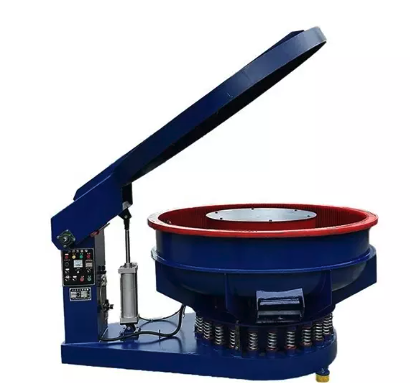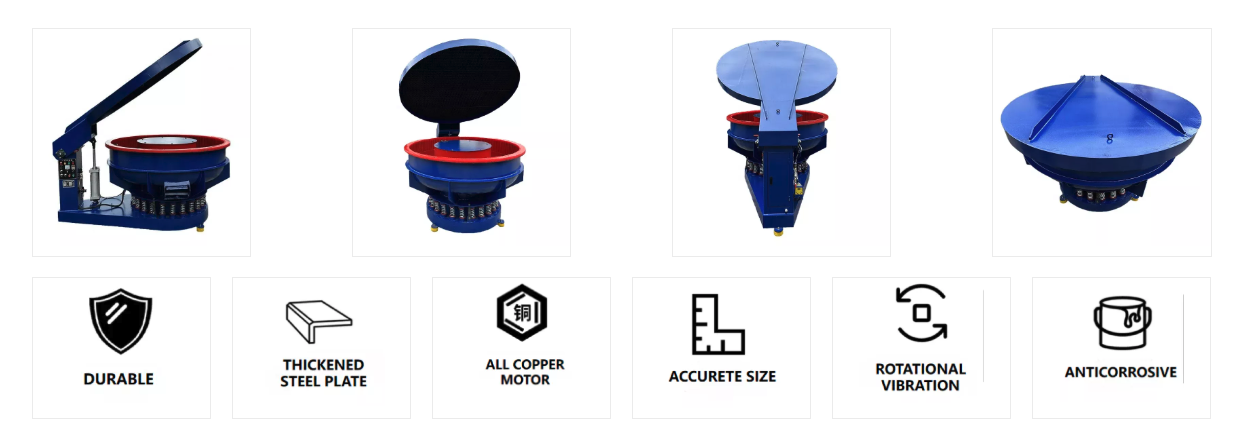- Home
- Machine
- Media
- Application
- Service
- About Us
- Blogs
- Contact Us
- All
- Product Name
- Product Keyword
- Product Model
- Product Summary
- Product Description
- Multi Field Search


Views: 0 Author: Site Editor Publish Time: 2025-10-20 Origin: Site











When it comes to achieving smooth, polished surfaces efficiently, a vibratory polishing machine is one of the most effective tools in modern manufacturing. Whether you are finishing metal parts, jewelry, or precision components, this equipment helps improve surface quality while saving labor time. However, one of the most common questions buyers ask is: “What’s the price of a vibratory polishing machine?”
The answer depends on several factors — including machine size, capacity, material, and automation level. In this article, we’ll explore in detail how pricing is determined, what affects the overall cost, and how to choose the right model for your production needs without overspending.
A vibratory polishing machine smooths and polishes metal parts using vibration energy. Instead of manual grinding, it creates thousands of gentle impacts between workpieces and media inside a vibrating bowl or tub. These machines are essential in metal finishing, jewelry, and manufacturing industries.
Knowing what affects their price helps workshop owners and manufacturers make smarter buying decisions. A machine’s cost doesn’t just depend on size or power—it’s also influenced by features, brand, and energy use. Understanding these factors means fewer surprises later.
On average, the price of a vibratory polishing machine ranges from $500 to $9,900. Small benchtop units are budget-friendly, while large industrial systems cost more but offer higher capacity and efficiency. Whether you’re polishing jewelry or mass-producing automotive parts, there’s a model for every budget.

Prices vary based on design, power, and build quality. In general:
| Machine Level | Typical Price Range | Typical Users | Key Advantages |
|---|---|---|---|
| Entry-Level | $500–$2,000 | Hobbyists, small shops | Affordable, easy to use |
| Mid-Range | $1,950–$3,950 | Small to medium manufacturers | Balanced performance |
| High-End Industrial | $5,000–$9,900+ | Automotive, aerospace | Heavy-duty, high capacity |
Most buyers start by setting a budget, but it’s better to look at value over price. A higher upfront investment can pay off through durability, lower maintenance, and consistent finishing quality.
These compact machines are the most affordable, typically $500 to $2,000. They’re great for jewelry makers, model builders, or small workshops that polish light parts. The small bowl or bench design saves space and power.
However, these machines have limited capacity. They may not handle heavy or irregular parts efficiently. For small-scale operations or beginners, though, they’re a cost-effective starting point.
Mid-range vibratory polishing machines cost between $1,950 and $3,950. These are versatile units for daily industrial use. The larger bowl or tub allows for higher batch volumes and more uniform polishing.
They often include features like variable speed control, automatic timers, or soundproof lids. These models strike a balance between affordability and performance—ideal for workshops aiming to increase productivity without a huge investment.
At the top end, machines range from $5,000 to $9,900+. These heavy-duty systems handle large batches or big workpieces, such as automotive rims or aerospace components. They’re built for speed, durability, and precision.
Wheel polishing systems, for example, have higher torque and specialized tooling for mirror finishes. The higher cost reflects advanced engineering, better materials, and longer lifespan.
Several key elements determine how much you’ll pay for a vibratory finishing system. Let’s explore them one by one.
Each machine type serves a unique purpose:
Vibratory Wheel Polishing Machine: For alloy wheels and large metal rims.
Vibratory Bowl Finishing Machine: Versatile and widely used for small metal parts.
Vibratory Tub Finishing Machine: Designed for long or irregular workpieces.
Benchtop Vibratory Bowl: Compact and affordable, suitable for small-batch operations.
Prices increase with size and complexity. Bowl and tub finishers are the most common choices in manufacturing workshops.
Size directly affects cost and performance.
| Capacity (Liters) | Typical Use | Price Range |
|---|---|---|
| 30L–85L | Light-duty or small parts | $700–$2,800 |
| 170L–280L | Medium production | $1,950–$3,950 |
| 500L+ | Large-scale industrial work | $9,900+ |
A larger machine processes more parts per cycle, saving time in mass production. For occasional use, smaller units are usually sufficient.
Extra features often mean a higher price, but they also add convenience:
Variable Speed Control – Adjusts vibration intensity for precision results.
Noise Reduction Covers – Keeps the workplace quieter.
Automated Media Separation – Saves labor by sorting media automatically.
Digital Timers & Touch Panels – Enable better process control.
Upgraded machines cost more but increase efficiency, especially in continuous production.
Reputable brands charge a premium, but they deliver consistent quality and after-sales support. Well-known manufacturers often include longer warranties and better service options.
A generic machine may cost 30% less but could require frequent maintenance. For heavy-duty use, investing in a reliable brand can reduce downtime and repair costs.
The sticker price is just the start. Running and maintaining a vibratory polishing machine adds extra costs over time.
Polishing media are consumables that need regular replacement. Each type suits different metals and finishes:
| Media Type | Use Case | Cost per kg | Durability |
|---|---|---|---|
| Ceramic | Hard metals, aggressive cutting | $3.30–$6.60 | High |
| Plastic | Soft metals, fine finishing | $2.60–$5.50 | Medium |
| Steel | Polishing, burnishing | $11–$15 | Very high |
| Organic (corn cob, walnut shell) | Gentle drying, soft finishing | $2–$3.30 | Low |
The wrong media can shorten machine life or damage workpieces, so selection matters as much as cost.
All machines wear out. Motors, linings, and bowls may need replacement after extended use.
High-end units have durable linings and require less frequent servicing, reducing downtime and total cost of ownership.
Regular checks prevent unexpected breakdowns and extend machine life.
Shipping fees depend on weight and destination—typically $100 to $300.
Some suppliers include delivery in the purchase price, so always confirm before ordering.
Installation can be DIY for smaller models. Professional setup might cost $100–$500 if alignment or rigging is needed.
Power consumption affects monthly costs.
| Machine Size | Power Usage | Estimated Monthly Cost (8 hrs/day) |
|---|---|---|
| Small Benchtop | 0.3–0.4 kW | $8–$12 |
| Standard Industrial | 0.37–5 kW | $10–$144 |
| Large Industrial | 5–10 kW | $144–$288 |
Energy-efficient models with auto shut-off or speed control can cut power bills significantly.
Before investing, carefully assess your finishing volume and part size. A small bench-top vibratory polishing machine is ideal for low-volume or delicate work, while a large industrial bowl or tub model suits heavy-duty applications. Choosing the right capacity ensures you don’t overpay for unused performance or underinvest in productivity.
The vibratory polishing machine price is only part of the investment. Factor in electricity consumption, media replacement, maintenance, and potential downtime. A slightly higher upfront cost can pay off if the machine is more energy-efficient and durable over time.
Not all machines are built or serviced equally. Always compare suppliers’ warranty terms, technical support, and spare parts availability. A trusted manufacturer — such as Huzhou Norden Machinery Factory — provides comprehensive service that ensures long-term reliability and peace of mind.
Polishing media, compounds, and water usage contribute significantly to running costs. Ask your supplier for guidance on the best consumable types and how often they need replacement. Efficient designs can reduce waste and extend media life, saving you money in the long run.
If your business is expanding, consider a vibratory polishing machine with room to scale. A slightly larger bowl capacity or automation-ready model can accommodate higher output later, avoiding the cost of frequent upgrades or replacements.
Don’t focus solely on the purchase price. A machine with faster cycle times, better vibration control, and easier unloading will boost throughput and reduce labor costs. Over time, higher operational efficiency directly translates into greater profitability and faster ROI.

Most models fall between $500 and $9,900, depending on size and features.
Each machine has unique design, power rating, and material quality. Brands with proven reliability cost more due to better parts and service.
Yes—if you need consistent results and process large volumes. Industrial machines save labor and energy over time.
Typically after several hundred hours of use. Frequency depends on media type and material hardness.
Capacity, type, power usage, and support availability are top priorities. Always check warranty terms.
Understanding the vibratory polishing machine price involves more than just comparing numbers — it’s about balancing performance, durability, and return on investment. By evaluating your finishing requirements, part sizes, and production scale, you can choose a model that delivers long-term value and consistent results.
If you are looking for a reliable supplier, Huzhou Norden Machinery Factory offers a wide range of vibratory polishing machines designed for efficiency, precision, and low maintenance. With decades of experience and a strong focus on quality, Norden Machinery helps manufacturers around the world achieve superior surface finishing results at competitive prices.